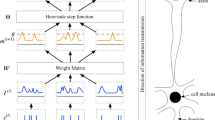Abstract
We study the effects of different bio-synaptic membrane potential mechanisms on the inference speed of both spiking feed-forward neural networks and spiking convolutional neural networks. These mechanisms are inspired by biological neuron phenomena include electronic conduction in neurons and chemical neurotransmitter attenuation between presynaptic and postsynaptic neurons. In the area of spiking neural networks, we model some biological neural membrane potential updating strategies based on integrate-and-fire (I&F) spiking neurons. These include the spiking neuron model with membrane potential decay (MemDec), the spiking neuron model with synaptic input current superposition at spiking time (SynSup), and the spiking neuron model with synaptic input current accumulation (SynAcc). Experiment results show that compared with the general I&F model (one of the most commonly used spiking neuron models), SynSup and SynAcc can effectively improve the spiking inference speed of spiking feed-forward neural networks and spiking convolutional neural networks.









Similar content being viewed by others
References
Bodyanskiy Y, Dolotov A, Pliss I, Malyar M (2016) A fast learning algorithm of self-learning spiking neural network. In: IEEE international conference on data stream mining & processing, pp 104–107. https://doi.org/10.1109/DSMP.2016.7583517
Bohte SM, Kok JN, Poutre HL (2002) Error-backpropagation in temporally encoded networks of spiking neurons. Neurocomputing 48(1):17–37. https://doi.org/10.1016/S0925-2312(01)00658-0
Camunas-Mesa L, Zamarreno-Ramos C, Linares-barranco A, et al. (2012) An event-driven multi-kernel convolution processor module for event-driven vision sensors. IEEE Journal of Solid-State Circuits 47 (2):504–517. https://doi.org/10.1109/JSSC.2011.2167409
Cao Y, Chen Y (2014) Spiking deep convolutional neural networks for energy-efficient object recognition. Int J Comput Vis 113(1):54–66. https://doi.org/10.1007/s11263-014-0788-3
Carlson KD, Nageswaran JM, Dutt N, Krichmar JL (2014) An efficient automated parameter tuning framework for spiking neural networks. Front Neurosci 8. https://doi.org/10.3389/fnins.2014.00010
Diehl PU, Neil D, Binas J, Cook M, Liu SC, Pfeiffer M (2015) Fast-classifying, high-accuracy spiking deep networks through weight and threshold balancing. In: International joint conference on neural networks. https://doi.org/10.1109/IJCNN.2015.7280696
Fang H, Wang Y, He J (2010) Spiking neural network for cortical neuronal spike train decoding. Neural Comput 22(4):1060–1085. https://doi.org/10.1162/neco.2009.10-08-885
Gutig R, Sompolinsky H (2006) The tempotron: a neuron that learns spike timing-based decisions. Nat Neurosci 9(3):420–428. https://doi.org/10.1038/nn1643
Huang S, Rozas C, et al. (2014) Associate hebbian synaptic plasticity in primate visual cortex. J Neurosci 34(22):7575–7579. https://doi.org/10.1523/JNEUROSCI.0983-14.2014
Humphries MD, Gurney K (2007) Solution methods for a new class of simple model neurons. Neural Comput 19(12):3216–3225. https://doi.org/10.1162/neco.2007.19.12.3216
Johnson AP, Liu J, Millard A, et al. (2017) Homeostatic fault tolerance in spiking neural networks: A dynamic hardware perspective. IEEE Transactions on Circuits and Systems-I: Regular Papers, pp 1–13. https://doi.org/10.1109/TCSI.2017.2726763
Kennedy J, Eberhart R (1995) Particle swarm optimization. In: IEEE International Conference on Neural Networks, pp 4
Lehky SR (2010) Decoding poisson spike trains by gaussian filtering. Neural Comput 22 (5):1245–1271. https://doi.org/10.1162/neco.2009.07-08-823
Lin Z, Shen J, Ma D, Meng J (2017) Quantisation and pooling method for low-inference-latency spiking neural networks. Electron Lett 53(20):1347–1348. https://doi.org/10.1049/el.2017.2219
Maass W (1997) Networks of spiking neurons: The third generation of neural network models. Neural Netw 9(10):1659–1672. https://doi.org/10.1016/S0893-6080(97)00011-7
Masquelier T, Thorpe SJ (2007) Unsupervised learning of visual features through spike timing dependent plasticity. PLoS Comput Biol 3(2):e31. https://doi.org/10.1371/journal.pcbi.0030031
McMahon DB, Leoplod DA (2012) Stimuls timing-dependent plasticity in high-level vision. Curr Biol 22(4):332–337. https://doi.org/10.1016/j.cub.2012.01.003
Meliza CD, Dan Y (2006) Receptive-field modification in rat visual cortex induced by paired visual stimulation and single-cell spiking. Neuron 49(2):183–189. https://doi.org/10.1016/j.neuron.2005.12.009
Merolla P, Arthur J, Akopyan F, et al. (2011) A digital neurosynaptic core using embedded crossbar memory with 45pj per spike in 45nm. IEEE Custom Integrated Circuits Conference. https://doi.org/10.1109/CICC.2011.6055294
O’Connor P, Neil D, Liu SC, Delbruck T, Pfeiffer M (2013) Real-time classification and sensor fusion with a spiking deep belief network. Front Neurosci 7. https://doi.org/10.3389/fnins.2013.00178
Rossum V, W MC, Turrigiano GG, Nelson SB (2002) Fast propagation of firing rates through layered networks of noisy neurons. J Neurosci 22(5):1956–1966. https://doi.org/10.1523/JNEUROSCI.22-05-01956.2002
Rueckauer B, Lungu IA, Hu Y, Pfeiffer M (2016) Theory and tools for the conversion of analog to spiking convolutional neural networks. arXiv:1612.04052 [cs, stat]
Schrauwen B, Campenhout JV (2004) Improving spike-prop: Enhancements to an error-backpropagation rule for spiking neural networks. Proceedings of ProRISC Workshop 11:301–305
Skocik MJ, Long LN (2014) On the capabilities and computational costs of neuron models. IEEE Trans Neural Netw Learn Syst 25(8):1474–1483. https://doi.org/10.1109/TNNLS.2013.2294016
Tino P, Mills AJS (2006) Learning beyond finite memory in recurrent networks of spiking neurons. Neural Comput 18(3):591–613. https://doi.org/10.1162/neco.2006.18.3.591
Ventura V, Todorova S (2015) A computationally efficient method for incorporating spike waveform information into decoding algorithms. Neural Comput 25(5):1033–1050
Zhang A, Zhou H, Li X, Zhu W (2019) Fast and robust learning in Spiking Feed-forward Neural Networks based on Intrinsic Plasticity mechanism. Neurocomputing 365:102–112. https://doi.org/10.1016/j.neucom.2019.07.009
Zhang S, Zhang A, Ma Y, Zhu W (2019) Intrinsic plasticity based inference acceleration for spiking Multi-Layer perceptron. IEEE Access 7:73685–73693. https://doi.org/10.1109/ACCESS.2019.2914424
Author information
Authors and Affiliations
Corresponding author
Ethics declarations
Conflict of interests
The authors declare that they have no conflict of interest.
Additional information
Publisher’s note
Springer Nature remains neutral with regard to jurisdictional claims in published maps and institutional affiliations.
Rights and permissions
About this article
Cite this article
Zhou, Y., Zhang, A. Improved integrate-and-fire neuron models for inference acceleration of spiking neural networks. Appl Intell 51, 2393–2405 (2021). https://doi.org/10.1007/s10489-020-02017-3
Accepted:
Published:
Issue Date:
DOI: https://doi.org/10.1007/s10489-020-02017-3




